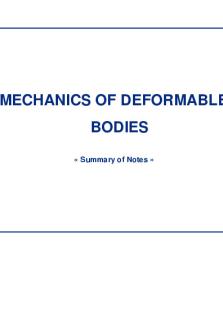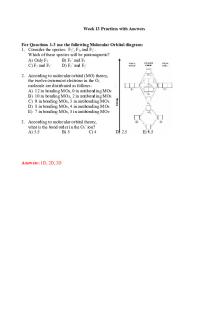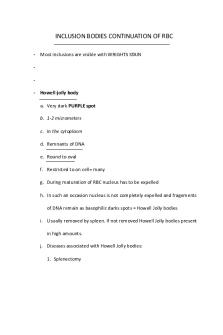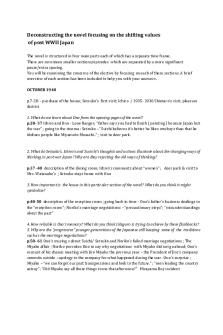F2; Stability of Floating Bodies PDF

| Title | F2; Stability of Floating Bodies |
|---|---|
| Course | Study Skills |
| Institution | Universiti Teknologi MARA |
| Pages | 10 |
| File Size | 332.9 KB |
| File Type | |
| Total Downloads | 172 |
| Total Views | 501 |
Summary
EXPERIMENT 2TITLE: STABILITY OF FLOATING BODIES1 OBJECTIVEa) To determine how the floating characteristics of a pontoon change as it is loaded with weight and tilts. b) To determine the metacentric height of a pontoon an to investigate its stability2 INTRODUCTIONThe Fluid Properties (and Hydrostatic...
Description
MEC294: Thermofluids Lab (Fluid Mechanics Laboratory)
EXPERIMENT 2 TITLE: STABILITY OF FLOATING BODIES
1.0 OBJECTIVE a) To determine how the floating characteristics of a pontoon change as it is loaded with weight and tilts. b) To determine the metacentric height of a pontoon an to investigate its stability
2.0 INTRODUCTION The Fluid Properties (and Hydrostatic Study) has been designed to demonstrate and provide student with hands on experience and fully understand how the properties of fluids and their behaviour under hydrostatic conditions. Application of Pascal’s Law and Archimedes’s Law is important to determine properties such as density, viscosity, and surface tension of fluid. By understanding the basic mechanics and properties of fluid, student will be able to go through a wide range of application of hydrostatic principles, including buoyancy, centre of pressure, floatation and stability of floating bodies, measurement of barometric pressure, operation and calibration of Bourdon pressure gauge.
3.0 THEORY Pontoon is a term used to denote a flat bottomed vessel which is rectangular in cross section and in plan. Considering Figure 1, we have the weight force, W, acting vertically down through the centre of gravity, G, of the pontoon. Since the pontoon is floating in water with a constant depth immersion, it follows that there must be an equal force acting the opposing direction of the weight force, known as buoyancy force, F, which acts vertically up through the centre of gravity of the displaced water.
1
MEC294: Thermofluids Lab (Fluid Mechanics Laboratory)
W
G
B
F
Figure 1: A pontoon floating on an even keel with W and F collinear
Since the pontoon is a simple rectangle, the shape of the displaced liquid is also a rectangle with its centre at the geometrical centre namely the centre of buoyancy, B. The buoyancy force, F acts upwards through B. Note that W and F act collinearly with G situated some distance above B.
W
G B B*
F
Figure 2: A pontoon floating with an imposed angle of tilt, showing the righting couple
When a pontoon is tilted as shown in Figure 2, W acts vertically down through G which maintained at the same position but F now acts through point B* instead of B. This is because F acts through the centre of gravity of the displaced liquid which is now trapezoidal in shape with its centre of gravity at B*. As a result F and W are no longer collinear, but a couple of forces that will return the pontoon to an even keel are formed. This is known as righting couple. In this case the pontoon is capable of righting itself when tilted, hence it is stable.
2
MEC294: Thermofluids Lab (Fluid Mechanics Laboratory)
W G
B*
B
F
Figure 3: A pontoon with a raised G and an imposed angle of tilt, showing the overturning couple caused by W acting outside F
If a relatively tall piece of weight is placed on the pontoon as shown in Figure 3, the combined weight, W of the pontoon and its load acts through the centre of gravity, G which is relatively high. When G becomes higher and the angle of tilt increases, W acts further and further to the left. This means that at some point the movement of the buoyancy force, F from B to B* is unlikely to be large enough to produce a righting couple. What happen now is the situation depicted in Figure 3, where the line of action of W is outside (nearer the edge of the pontoon) than the line along which F acts. Thus W is trying to overturn the pontoon. The two forces F and W form an overturning couple. Thus it is unstable.
M
G B B*
F
Figure 4: The position of metacentre
3
MEC294: Thermofluids Lab (Fluid Mechanics Laboratory)
A pontoon floating on an even keel has its centre of buoyancy at B and its centre of gravity at G. A line joining B to G would be as shown in Figure 1, that is vertical and at 90º to the deck of the pontoon. Imagine line BG extends upwards and now consider the pontoon in its tilted position as in Figure 4, the centre of buoyancy moved from B to B*. A line drawn vertically upwards through B* will intersect the line BG at the point labelled M in the diagram. This is called the metacentre. Provided G does not move, then for all relatively small angle of tilt: 1. The vertical line through B* through M. Consequently if the location of B* can be calculated, the position of M can be found graphically. 2. The distance of M above B is constant. 3. The distance GM is called the metacentric height of the pontoon. When considering the stability of a floating body, it is usual to assume that the angle of tilt θ is small. This is necessary to simplify the theory by making the assumption that θ radians = sin θ = tan θ = θ radians. Considering the restoring moment that rights a rectangular pontoon to an even keel when it is tilted, the equation: BM Iws V
Where; V = the volume of water displaced by the body Iws= the second moment of the area
X
I
X b
Figure 5: Plan of the pontoon where the tilt takes place about the longitudinal axis X-X
4
MEC294: Thermofluids Lab (Fluid Mechanics Laboratory)
Iws
lb 3 12
It should be apparent that BM depends only upon: 1. l and b, the dimensions of the pontoon which govern the value of Iws. 2. V, the volume of displaced water which depends only upon the weight of the pontoon. Referring to Figure 6, it is understood that BM = BG + GM or, GM = BM - BG By calculating BG, then GM can be obtained and hence determine if the body is stable or unstable. Now, B is the centre of buoyancy, and with the pontoon floating on an even keel B is located at a height equal to half the depth of immersion (h/2) above the point O on the bottom of the pontoon.
M
GM
G
OG by taking moments about O
B O
h/2
H=V/lb
Figure 6: A pontoon showing the key points and dimensions
It is common practice to carry out an experiment on a vessel to assess its stability by calculating GM. This is a simple procedure utilizing movable weight positioned on the deck at approximately the middle of the longitudinal centreline and a pendulum hanging inside the vessel. The weight namely jockey weight (wj) is moved from the centreline a known distance (x) towards the side as shown in Figure 7. This moves the centre of gravity of the pontoon from G on the centreline to a new position G* and causes the vessel to tilt at the angle of θ. The magnitude of GG* depends upon how far the jockey weight is moved and its size relatively to the total weight of the pontoon. Using the ratio of weights and x,
5
MEC294: Thermofluids Lab (Fluid Mechanics Laboratory)
wj GG * x W
where W is the total weight of the pontoon including the pontoon. GG* = GM tanx Combining both equations, wj dx GM W d
It is important to remember that θ is in radian.
M dθ Jockey Weight
dx
G
G* B*
B
Figure 7: Movement of the jockey weight from the centreline
6
MEC294: Thermofluids Lab (Fluid Mechanics Laboratory)
4.0 APPARATUS
1
2 3
7
4
8
5 6 Figure 8: Fluid Properties and Hydrostatic Study
A self-contained and bench equipment with all the apparatus needed for a comprehensive range of experiments on properties of fluids and hydrostatics. Table 1: Detail components of floating body
1. 2. 3. 4.
Mast Sliding mass Linear scale Adjustable mass
5. Transverse shaft 6. Pontoon body (dimension; L x W = 315 x 180) 7. Plumb-line (string) 8. Pendulum
5.0 PROCEDURE 1. Open the transverse adjustable mass and measure the weight of adjustable mass. 2. Re-assemble the adjustable mass to the pontoon. 3. Measure the whole set of pontoon body. 4. Position the sliding mass along the mast such that the centre of gravity occurs at the top of the pontoon. This can be determined by using either a knife edge or by suspending from a light string around the mast.
7
MEC294: Thermofluids Lab (Fluid Mechanics Laboratory)
5. Fill the sink with water, float pontoon ensuring that the adjustable mass is in its central position. 6. Check zero datum between plumb line and scale. 7. Move adjustable mass to the right of centre in 10 mm increments to the end of the scale, noting the angular displacement of the plumb line for each position. 8. Repeat for movement of the adjustable mass to the left of centre. 9. With the exception of weighing the adjustable weight and emptying and refilling the volumetric tank, repeat the experiment step 6 – step 8 for the sliding mass at different heights up the mast, 50 mm and 100 mm (for different centres of gravity). 10. Record all reading in the result sheet (Table 2). 11. The water in the sink can be discharge by opening valve V7.
6.0 RESULT AND ANALYSIS 1. Record the data obtained on the result sheets (Table 2 and Table 3). 2. Obtain the values of angle of list for each sliding mass height and parameter. Fill all the values into the Table 2. 3. Show the sample calculation of the second moment of area, volume of water displaced, height of metacentric above buoyancy, depth of immersion of pontoon, centre of buoyancy and metacentric height for the sample data of 50mm height with left displacement of 7.5mm. 4. Plot a graph of the variation of angle of list with lateral position of weight (right) and variation of angle of list with lateral position of weight (left). 7.0 DISCUSSION 1. Explain the graphs obtained from the experiment including the reasons why the graphs are in such form? 2. What happen to the metacentre, M and stability of the pontoon when the height of sliding mass is at 0 mm, 50 mm and 100 mm? (make a comparison) 3. Discuss the stability of (a) a submerged and (b) a floating body whose centre of gravity is above the centre of buoyancy. 4. Explain what types of errors are identified during the experiment, and explain how it affects the experimental result? (Please specify other than parallax error) 5. Explain why stability is an important consideration for safety for floating body such as ships?
8
MEC294: Thermofluids Lab (Fluid Mechanics Laboratory)
Table 2: Experimental Results 0 mm height Parameter Displacement (mm) Angle (degree) (mm) right left right left 0 10 20 30 40 50 60 70 80
50 mm height Displacement (mm) Angle (degree) right left right left
9
100 mm height Displacement (mm) Angle (degree) right left right left
MEC294: Thermofluids Lab (Fluid Mechanics Laboratory)
Table 3: Metacentric Height Metacentric Height (cm) Parameter (mm)
0 mm height right left
50 mm height right left
0 10 20 30 40 50 60 70 80
10
100 mm height right left...
Similar Free PDFs

F2; Stability of Floating Bodies
- 10 Pages

F2
- 433 Pages

Equilibrium of Rigid Bodies
- 27 Pages

Mechanics of Deformable Bodies
- 16 Pages

F2- OIC
- 133 Pages

General Stability of Emulsions
- 4 Pages

F2 Verhaltensbeobachtung
- 3 Pages

F2. l\'école de birmingham
- 5 Pages

Floating Point Representation
- 5 Pages
Popular Institutions
- Tinajero National High School - Annex
- Politeknik Caltex Riau
- Yokohama City University
- SGT University
- University of Al-Qadisiyah
- Divine Word College of Vigan
- Techniek College Rotterdam
- Universidade de Santiago
- Universiti Teknologi MARA Cawangan Johor Kampus Pasir Gudang
- Poltekkes Kemenkes Yogyakarta
- Baguio City National High School
- Colegio san marcos
- preparatoria uno
- Centro de Bachillerato Tecnológico Industrial y de Servicios No. 107
- Dalian Maritime University
- Quang Trung Secondary School
- Colegio Tecnológico en Informática
- Corporación Regional de Educación Superior
- Grupo CEDVA
- Dar Al Uloom University
- Centro de Estudios Preuniversitarios de la Universidad Nacional de Ingeniería
- 上智大学
- Aakash International School, Nuna Majara
- San Felipe Neri Catholic School
- Kang Chiao International School - New Taipei City
- Misamis Occidental National High School
- Institución Educativa Escuela Normal Juan Ladrilleros
- Kolehiyo ng Pantukan
- Batanes State College
- Instituto Continental
- Sekolah Menengah Kejuruan Kesehatan Kaltara (Tarakan)
- Colegio de La Inmaculada Concepcion - Cebu






